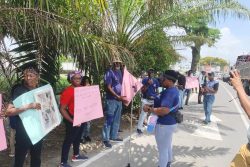This week’s 25th Inter-Sessional Meeting of Caricom Heads of Government has been preceded by much commentary on the extent to which the community has been particularly timely in meeting the agenda which it has set for itself since the 1989 Grande Anse Declaration and the formal establishment of the Caricom Single Market and Economy (CSME). Much of this commentary has been marked by despair as to whether heads of government have been sufficiently enthusiastic and practically determined to achieve the goals which they, or their predecessors, have set. And indeed, much of the despair has been characterized by doubt as to whether the heads have given the community, and therefore themselves, the kind of institutional machinery that can ensure the progressive implementation of the CSME.
Commentators have noted that the contours of the global economy and polity have changed extensively since the Grande Anse Declaration. The demise of the Soviet Union had not yet taken place, so while there were signs of a certain change of thinking in the Soviet Union, and some emerging rapprochement between the two superpowers, the globe was still geopolitically and ideologically divided into two, even as the non-aligned powers exerted themselves to ensure that they were not caught in the trap of institutional antagonism still characterising the globe.
On the other hand our heads of government, some of their countries engulfed in the economic recession dominating the Latin American and Caribbean sphere, had begun to consider how they could accommodate to the newly dominating philosophy of economic liberalization sanctified by the IMF and the World Bank, without giving up the commitment to social democracy which they had inherited from the Britsh metropole. But soon it became clear that the terms of liberalization and, with the dissolution of the Soviet camp, those of globalization, would be the dominating frames into which the commitment to Single Market and Economy would have to be made real.
A phenomenon, however, of which perhaps more notice would have been taken by Caricom leaders at that time, was the determination in the middle of the 1980s by the countries of the European Community that the economic direction and the institutional arrangements of their own community would have to fundamentally change. And further, that the change would have to be concluded within a relatively short space of time – by 1992.
Sir Shridath Ramphal’s 1992 Report of the West Indian Commission: Time for Action, reference to which is so often made, can be seen as a Caribbean reflection of the commitment to change elaborated by the Europeans, impelled by the clear understanding that the historical economic relationship between the Caribbean and Western Europe would have to change.
But virtually at the start of their presumed commitment to change, it would appear that the heads faltered, and that in a sense, they broke away from the commitment to combined economic and institutional change which had characterized the European Community’s own commitment. The heads accepted the by now global commitment to trade liberalization and implied adjustment of the Common External Tariff. They accepted the necessity for taking the path of single market with a consequent single economy. But they in effect rejected the necessity for a fundamental change in the governance system of Caricom, to permit the institutional sticking of their CSME decisions within appropriate time frames. And this faltering was reinforced, a little later, by the half-hearted commitment to a Caribbean Court of Justice, not by any of the smaller countries, but by the dominant partners of the community, Jamaica and Trinidad & Tobago.
And largely, there we are today, as heads of government set and reset deadlines for implementation of the various stages of the CSME, and for establishment of an appropriate governance system. And while it is certainly true that there have been major steps in the realm of functional cooperation – particularly in education, health and security cooperation – the latter partially impelled by United States’ concerns, there is no doubt that the community is increasingly defined by its inability to make progress on the economic front – with the commitment to freedom of movement seeming to be redefined by fears of the effects of intra-regional migration affecting the economies of particular countries in a time, and fear of economic recession. And there seems little optimism that the heads are reaching a conclusion on the so-called governance issue bugging us since 1992.
Recent statements by the intellectual doyen of the integration movement, Sir Shridath, seem to reflect the consequent pessimism abounding. The outburst of antagonism to the secretariat among government leaderships themselves in the last period of Secretary General Carrington’s tenure, and widespread doubt as to whether the mode of choosing a new Secretary-General is really a serious one, send signals to the Caricom citizenry of failing commitment to the process, in spite of stout words at each Inter-sessional or Annual Heads Conference. For in between these, the old complaints arise – whether Trinidad now has a dominating advantage in the economic integration process; whether a court constituted of Caribbean citizens (in spite of the fact that the current CCJ court actually has one European on it) can be fair; whether the idea of a Single Market is outmoded as new horizons for cooperation appear that are not necessarily Caribbean-wide, but link neighbouring countries in more limited geographical sub-regions – the emerging idea of a Northern Caribbean economic arena; extensive physical linkage (so-called infrastructural integration) between Guyana and Brazil permitting a more meaningful continental destiny for the former country; former Prime Minister Patrick Manning’s vocation (now discarded by the new Trinidad government) of a more restricted Trinidad-Eastern Caribbean political arrangement, indeed reflecting the financial and trading dominance of those smaller states by Trinidad, while the other countries dallied; and even a commitment to a wider hemispheric infrastructural integration, based on more easily available financial resources, as the larger countries of the hemisphere find their feet as ‘emerging economies.’
Our current arrangement with the European Union in the aftermath of the EPA negotiations, must also throw doubt and concern too in those quarters, as to what sub-regional (taking the hemisphere now as the region) and institutional dispensation we really favour in the emerging economic geography of a Caribbean more embedded in Latin and North America.
Perhaps our heads, tied up as they undoubtedly now are, in solving domestic economic problems need to take some time during their two-day Grenada grind of issues of our unfinished Single Market, to ‘see ourselves as others see us’ presently; and to discuss whether what we say we are doing is what others accept as what we are doing. And if not, why not.








